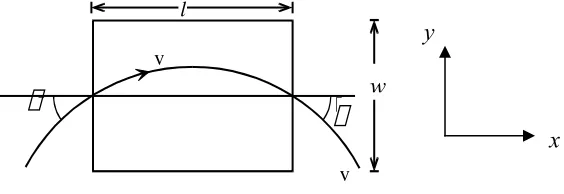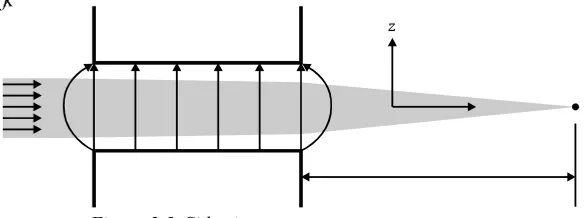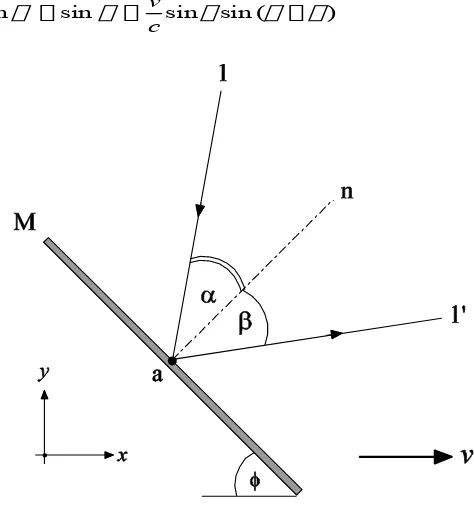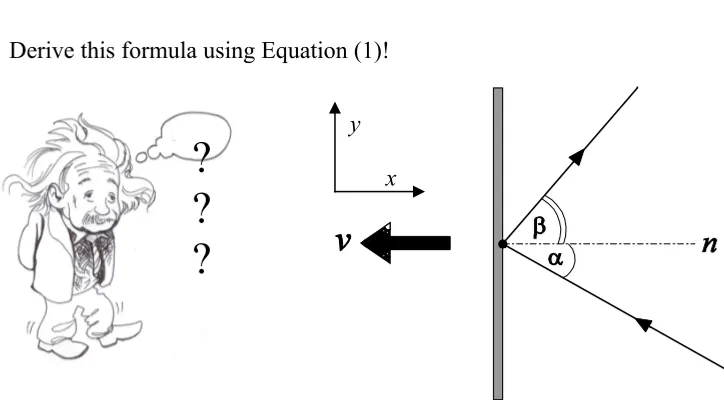Question 1
1A. SPRING CYLINDER WITH MASSIVE PISTON (5 points)
Consider n=2 moles of ideal Helium gas at a pressure P0 and temperature T0 = 300 K placed in a vertical
cylindrical container (see Figure 1.1). A moveable frictionless horizontal piston of mass M = 50 kg (assume g = 9.8 m/s2 ) and cross section A = 100 cm2
compresses the gas leaving the upper section of the container void. There is a vertical spring attached to the piston and the upper wall of the container. Initially the system in equilibrium and the spring is unstreched. Then the piston is pushed down until the gas volume halved, and released. Disregarding any gas leakage through their surface contact, and neglecting the specific thermal capacities of the container, piston and spring, calculate
a. the gas volume when the piston velocity is 4 0
5 gV
A (3 points)
b. the frequency f of small oscillation of the piston, when it is slightly displaced from equilibrium position. (2 points)
Let the spring constant k = MgA/V0 (note V0 is the initial volume of gas). All the
processes in gas are adiabatic. Gas constant R = 8.314 JK-1mol-1.
For monoatomic gas
(Helium) use Laplace constant = 5/3.
SPRING
PISTON
GAS
Solution:
The initial volume of gas
0 0 Eq. (3) can also be obtained by calculating the internal energy change (without
integration)
0'
gas V
W E nC T T (4)
where T0' is the temperature when the gas volume is V0/2. The change of the gravitational potential energy
The change of the potential energy of the spring
spring kx kx
V V V V
The kinetic energy
2 4 0 2 0
By conservation of energy, we have
gas PE spring
With = 5/3 we get
2/ 3 2 2 / 3
1 11 3 1
0
2s 40 2 s 2
(12) Solving equation (12) numerically, we get
s1 = 0.74 and s2 = 1.30
Therefore 1 0.74 0 0.74 0 75.3litres
nRT A
V V
Mg
b) Small Oscillation (2 points)
The equation of motion when the piston is displaced by x from the equilibrium position is
The frequency of the small oscillation is
[Marking Scheme]
THEORETICAL Question 1A
Spring Cylinder with Massive Piston
a. (3.0) 0.2 Initial Pressure P0 = Mg/A
Gravitational Potential Energy 0
1
0.3 Spring Potential Energy
2
Approximation 0
0
1B. THE PARAMETRIC SWING (5 points)
A child builds up the motion of a swing by standing and squatting. The trajectory followed by the center of mass of the child is illustrated in Fig. 1.2. Let ru be the radial
distance from the swing pivot to the child’s center of mass when the child is standing, while rd is the radial distance from the swing pivot to the child’s center of mass when
the child is squatting. Let the ratio of rd to ru be 21/10 = 1.072, that is the child moves its
center of mass by roughly 7% compared to its average radial distance from the swing pivot.
To keep the analysis simple it is assumed that the swing be massless, the swing amplitude is sufficiently small and that the mass of the child resides at its center of mass. It is also assumed that the transitions from squatting to standing (the A to B and the E to F transitions) are fast compared to the swing cycle and can be taken to be instantaneous. It is similarly assumed that the squatting transitions (the C to D and the G to H transitions) can also be regarded as occurring instantaneously.
Figure 1.2
Solution (5 points)
(1) The conservation of angular momentum (CAM)
2
L I Mr (M= mass of the child which dominated the mass of the swing
and r = distance of the child’s center of mass to the swing’s pivot P, = the swing’s angular velocity with respect to P) during the passage of the swing through its equilibrium/vertical position when r changes from rd to ru in either
direction. If d and u are the angular velocity before and after the (very brief 1st
type) transition, then according to CAM,
2 2 so that ( / )2
d d d u u u u d u d
L Mr L Mr r r (1)
hence each time the swing repeat moving upward(twice in each cycle) its angular speed increases by factor of
(2) The conservation of Mechanical Energy of Rotation (CMER)
1 2 2 1 2
2 2
kin
E E V Mr Mgr Mgr
(2)
E is constant during the motion between the equilibrium position (where
, 0
V Mgr ) after 1st transition type and maximum angular position (where
is zero before the 2nd type of transition causing r changes ru to higher rd) or
vice versa. During the 2nd type transition with fixed, V increases from the
value 1 2
2Mgru to higher one
2 1
2Mgrd and with this potential energy, the swing
moves downward to give a higher value of the new angular velocity d at
equilibrium position before the 1st type of transition starts again. Application eq.
(2) to the end of the 2nd type and the start of the 1st leads to
This expression becomes the input of the next transition of 1st type giving an
For n complete cycles, the growth of angular velocity amplitude as well as the angular amplitudeA increases by a factor of
2
SOLUTION (approximation 4 points).
The moment of inertia with respect to the swing pivot
I = Mr2 (1)
Since the A to B transition is fast one has by conservation of angular momentum,
A A B B
I I (2)
The energy at point A is
2
1 2
A A A
E I (3)
The energy at point B is
2
The energy at point C (conservation of energy)
2
1 2
C B B B
E E I Mgh (5)
As the child squats at the C to D transition, the swing losses energy of the amount Mgh so
2
1 2
D B B
E I (6)
Energy at point E is equal to energy at point D (conservation energy)
2
1 2
E D B B
E E I (7)
2
Using Eq (2) this equation yields,
2 A 2
From this one obtains,
E d
This ratio gives the fractional increase in the amplitude for one half cycle of the swing motion. The fractional increase in the amplitude after n cycles is thus,
Substitute the values,
2
[Marking Scheme]
THEORETICAL Question 1B
The Parametric Swing
(5.0) 0.25 Moment of inertia I = Mr2
0.25 Conservation of angular momentum A to B IAA IBB
0.25 Correct expression of energy at point A 0.25 Correct expression of energy at point B 0.25 Correct expression of energy at point C 0.25 Correct expression of energy at point D 0.25 Correct expression of energy at point E 0.25 Conservation of angular momentum C to D 0.25
0.50
Conservation of energy 1 2
2
C B B B
E E I Mgh Conservation of energy ………
0.25 0.50
Conservation of energy 1 2
2
E D B B
E E I
Conservation of energy 0.25
Question 2
MAGNETIC FOCUSING
There exist many devices that utilize fine beams of charged particles. The cathode ray tube in oscilloscopes, in television receivers or in electron microscopes. In these devices the particle beam is focused and deflected in much the same manner as a light beam is in an optical instrument.
Beams of particles can be focused by electric fields or by magnetic fields. In problem 2A and 2B we are going to see how the beam can be focused by a magnetic field.
2A. MAGNETIC FOCUSING SOLENOID (4 points)
Figure 2.1 shows an electron gun situated inside (near the middle) a long solenoid. The electrons emerging from the hole on the anode have a small transverse velocity component. The electron will follow a helical path. After one complete turn, the electron will return to the axis. By adjusting the magnetic field B inside the solenoid correctly, all the electrons will converge at the same point F after one complete turn, and form an image of the hole on the anode.
Use the following data:
The voltage difference that accelerates the electrons V = 10 kilovolt The distance between the anode and the focus point F, L = 0.5 meter The mass of an electron m = 9.11x 10-31 kg
The charge of an electron e = 1.6 x 10-19 C Treat the problem non-relativistically
a) Calculate B! (3 points)
b) Find the current in the solenoid if the latter has 500 turns per meter. (1 point)
L Anode
Figure 2.1
SOLUTION
a) In magnetic field, the particle will be deflected and follow a helical path. Lorentz Force in a magnetic field B,
2
mv
ev B R
(1)
Where v is the transverse velocity of the electron, R is the radius of the path. Since v R (
2 T
is the particle angular velocity and T is the period), then, 2
m eB
T
(2)
To be focused, the period of electron T must be equal to
//
L
v , where v// is the parallel
component of the velocity. We also know,
2 2
2// //
1 1
2 2
eV m v v mv (3)
All the information above leads to
12 32
2 mVe
B
L
(4)
Numerically
B = 4.24 mT b) The magnetic field of the Solenoid:
0
[Marking Scheme]
THEORETICAL Question 2A
Magnetic Focusing Solenoid
a. (3.0) 0.3
0.5 Numerical value B = 4.23 mT b. (1.0) 0.5 B=0in
2B. MAGNETIC FOCUSING (FRINGING FIELD) (6 points)
Two pole magnets positioned on horizontal planes are separated by a certain distance such that the magnetic field between them be B in vertical direction (see Figure 2.2). The poles faces are rectangular with length l and width w. Consider the fringe field near the edges of the poles (fringe field is field particularly associated to the edge effects). Suppose the extent of the fringe field is b (see Fig. 2.3). The fringe field has two components Bx i and Bz k. For simplicity
assume that |Bx|= B|z|/b or explicitly:
when the particle enters the fringe field Bx = +B z /b,
when the particle enters the fringe field after travelling through the magnet, Bx = Bz b/
A parallel beam of particles of mass m and charge q enters the magnet (near the center) with a high velocity v parallel to the horizontal plane. The vertical size of the beam is comparable to the distance between the magnets. The beam enters the magnet at an angle from the center line of the magnet and leaves the magnet at an angle - (see
Figure 2.4. Assume is very small). You may treat this problem relativistically or
non-relativistically.
Figure 2.2. Overall view
Bx Bz
x z
x=b
Figure 2.3. Fringe field
Figure 2.4. Top view
x y
w l
v
v
y
x w
x z
w vl
y
The beam will be focused due to the fringe field. Calculate the approximate focal length if we define the focal length as illustrated in Figure 2.5 (assume b<<l and assume that the z-component of the deflection in the magnetic field B is very small).
Solution:
The magnetic force due to the fringe field on charge q with velocity v is
F qv B (1)
The z-component of the force obtained from the cross product is
sinz x y y x y x
qv Bz
F q v B v B qv B
b
(2)
The vertical momentum gained by the particle after entering the fringe field
sin sin
tan cos
z z
qvBz qvBz b
P F dt t qBz
b b v
(3)The particle undergoes a circular motion in the constant magnetic field B region
2
v
m qvB
R (4)
x
f
2 sin
qBR qBl
v
m m
(5) Therefore,
sin 2
qBl mv
(6)
After the particle exits the fringe field at the other end, it will gain the same momentum.
The total vertical momentum gained by the particle is
2 2
2 2 tan 2
2
z total z
qBl q B zl
P P qBz qBz
mv mv
(7)
Note that for small , we can approximate tansin
Meanwhile, the momentum along the horizontal plane (xy-plane) is
p = mv (8)
From the geometry in figure 4, we can get the focal length by the following relation,
z
P Z
p f
(9)
(10) 2 2
2 2
m v
f
q B l
[Marking Scheme]
THEORETICAL Question 2B
Magnetic Focusing (Fringing Field)
(6.0) 0.25 Lorentz Force F qv B
0.25 z-component
z x y y x
F q v B v B 0.25
z-component z y x sin
qv Bz
F qv B
b
0.5
z-component gained momentum Pz
F dtz0.75 Pz qBztan 0.5
Equation
2
v
m qvB
R
0.25 sin
2
qBl mv
0.5
z
2 ztotal
P P
(factor of 2) 0.25
2 2
z total
q B zl P
mv
0.5 Horizontal momentum p = mv 1.0
Equation Pz total Z
p f
1.0 2 2
2 2
m v
f
q B l
Question 3
RELATIVISTIC MIRROR
Reflection of light by a relativistically moving mirror is not theoretically new. Einstein discussed the possibility or worked out the process using the Lorentz transformation to get the reflection formula due to a mirror moving with a velocity
v. This formula, however, could also be derived by using a relatively simpler method. Consider the reflection process as shown in Fig. 3.1, where a plane mirror M moves with a velocity v veˆx
(where eˆx is a unit vector in the x-direction)
observed from the lab frame F. The mirror form forming an angle with respect to the velocity (note that 0
90
). The plane of the mirror has n as its normal. The
light beam has an incident angle and reflection angle which are the angles between n and the incident beam 1 and reflection beam 1', respectively. It can be
shown that,
) (
sin sin sin
sin
c v
(1)
3A. Einstein’s Mirror (2.5 points)
About a century ago Einstein derived the law of reflection of an electromagnetic wave by a mirror moving with a constant velocity vveˆx (see Fig. 3.2). By
applying the Lorentz transformation to the result obtained in the rest frame of the mirror, Einstein found that :
2 2
2 2
(1 ) cos 2 cos
1 2 cos
v v
c c
v v
c c
(2)
Derive this formula using Equation (1)!
Figure 3.2. Einstein mirror moving to the left with a velocity v.
3B. Frequency Shift (2 points)
If the incident light is a monochromatic beam hitting M with a frequency, find the new frequency ' after it is reflected from the surface of the moving mirror. If
0
30
and 0.6 c, find frequency shift in percentage of .
3C. Relativistically moving Mirror Equation (5.5 Points)
Derive Equation (1)!
?
?
?
Solution:
a) EINSTEIN’S MIRROR
By taking /2and replacing v with v in Equation (1) we obtain This equation can also be written in the form of
The square of this equation can be written in terms of a squared equation of cos , as
follows, which has two solutions,
b) FREQUENCY SHIFT
The reflection phenomenon can be considered as a collision of the mirror with a beam of photons each carrying an incident and reflected momentum of magnitude
/
f
p h cand pf 'h'/c, (9)
The conservation of linear momentum during its reflection from the mirror for the component parallel to the mirror appears as
2
c) RELATIVISTICALLY MOVING MIRROR EQUATION
Figure 3.3 shows the positions of the mirror at time t0 and t. Since the observer is
moving to the left, system is moving relatively to the right. Light beam 1 falls on point a at t0and is reflected as beam 1'. Light beam 2 falls on point d at t and is reflected as
beam 2 '. Therefore, ab is the wavefront of the incoming light at time t0. The atoms
at point a is disturbed by the incident wavefront aband begin to radiate a wavelet. The
disturbance due to the wavefront ab stops at time t when the wavefront strikes point
d. As a consequence
).
From the triangles aeo and afo we have eoaotan and of aotan. Since of
eo
ef , then
Figure 3.3.
0
( )sin tan tan
ef v t t (18)
By substituting Equations (14), (16), (17), and (18) into Equation (15) we obtain
0
cos sin sin
t t
ag v c
Figure 3.4.
and
0
sin cos sin
sin (tan tan ) c v
ag v t t
(20)
Eliminating ag/(tt0) from the two Equations above leads to
1 1 1 1
sin (tan tan ) sin
sin sin sin cos sin cos
v c v
(21)
By collecting the terms containing vsin we obtain
cos cos sin sin
sin
sin sin sin sin
v c
(22)
or
) sin( sin sin
sin
c v
[Marking Scheme]
THEORETICAL Question 3
Relativistic Mirror
A. (3.0) 0.5 Equation: sin sin sin()
Know how to calculate sin
For part C, if the students is not able to prove the equation maximum point is 2.5.
C. (5.0) 0.5 Figure 4.3
1.0 Equation
0
( )sin tan tan
ef v t t
0.5
0
cos sin sin
t t
ag v c
0.5
0
sin cos sin
sin (tan tan ) c v
ag v t t
2.5 sin sin sinsin( )
c v







